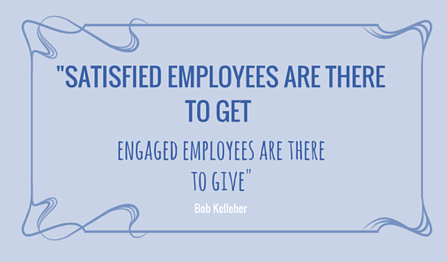
EMPLOYEE ENGAGEMENT
We see and hear the term “employee engagement” quite frequently these days but, depending on which of the 2,740,000 Google links you click on, the definition varies.
To some it’s a fleeting, new catchphrase for “Human Resources (HR)”, to others it means foosball tables, free donuts, or drinks on Friday after work…none of which are the definition, but maybe more so a vehicle to achieve employee engagement. In all honesty, we’re still defining what it means. I tend to agree with Kevin Kruse, author of Employee Engagement 2.0, who defines it as, “…the emotional commitment an employee has to the organization and its goals.” Gallup defines engaged employees as “those who are involved in, enthusiastic about and committed to their work and workplace,” which is along the same vein as Kruse.
So, let’s talk numbers…according to a recent Gallop poll, only 32% of employees in the US are engaged in the workplace. That is only 1 out of 3 employees…let that sink in for a second. A recent report from the State of the American Workplace indicated that 51% of employees are actively looking for a new job or watching for new job openings. These staggering statistics tell us that employee engagement, and the need for it, is very real for companies.
So, what do we do about it? Mike Kappel, contributor, for Fores.com, suggests these 5 Ways to Encourage Employee Engagement:
- Don’t Skip Onboarding And Training
Here at The MDC Group, we spend a lot of hours with all team members, discussing, creating, and improving onboarding processes and procedures, tailored to new and potential employees. We have asked ourselves what if you train people and they leave? Worse still, what if you don’t train them and they stay?
- Set Company Goals
At MDC, we have all-company quarterly meetings that are attended by every team member. We discuss group and divisional goals, solutions to issues, better ways to service our clients and we make SMART goals with a plan to follow. We strive to be less of firefighters and more of strategic planners (and trust me, the struggle is real). The question is, shouldn’t we consider that direction is so much more important than speed? Many people and companies are going nowhere fast.
- Acknowledge Employees
We have built-in many contests and activities to build camaraderie, centered around competition. This gives our team something, outside of daily responsibilities, to be proud of and acknowledged for in our workplace. We’ve all heard the saying, “You don’t build a business. You build people and then people build the business.”
- Focus On Employee Development
Culture is top-down, anyway, you slice it. Our CEO is a great example of investing in people, the whole person, not just the employee. We create annual and bi-annual development reviews for all team members focused specifically on helping them achieve their personal and professional goals. We focus on personal development – the never-ending chance to improve not only yourself but also to attract opportunities and affect others.
- Don’t Micromanage
Trust the experts you’ve hired. We have implemented the Predictive Index, to help lead and peers understand what makes our team member tick, how we best approach them, and ways to flex to meet their needs. “It doesn’t make sense to hire smart people and then tell them what to do; we hire smart people, so they can tell us what to do.” – Steve Jobs
There are a plethora of ways to achieve employee engagement and this varies from organization to organization, depending on their individual goals. Take inventory of your current culture and practices. I challenge you to create a new and improved strategic plan emphasizing employee engagement and see how much more your team has to give.

